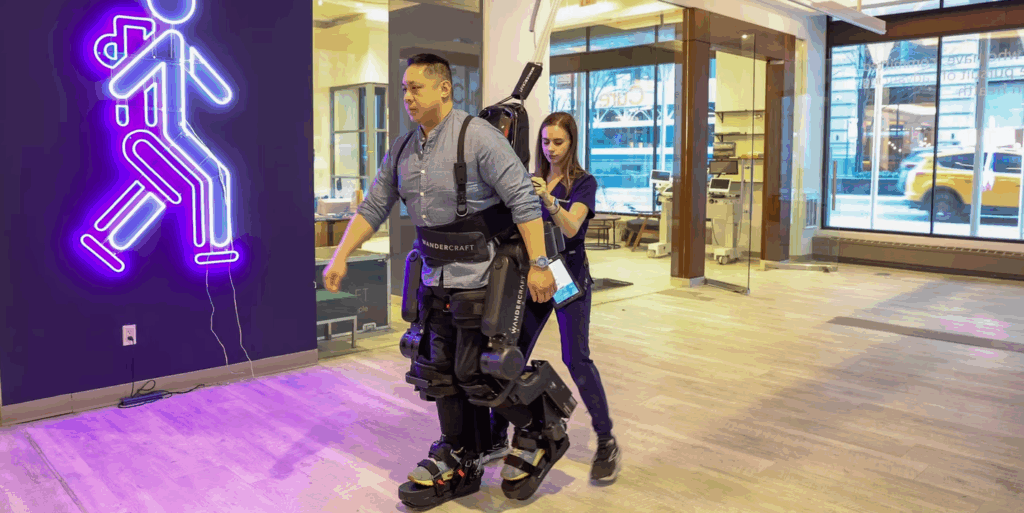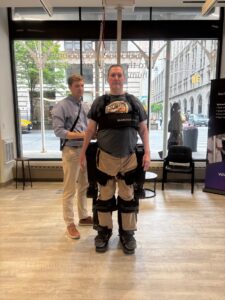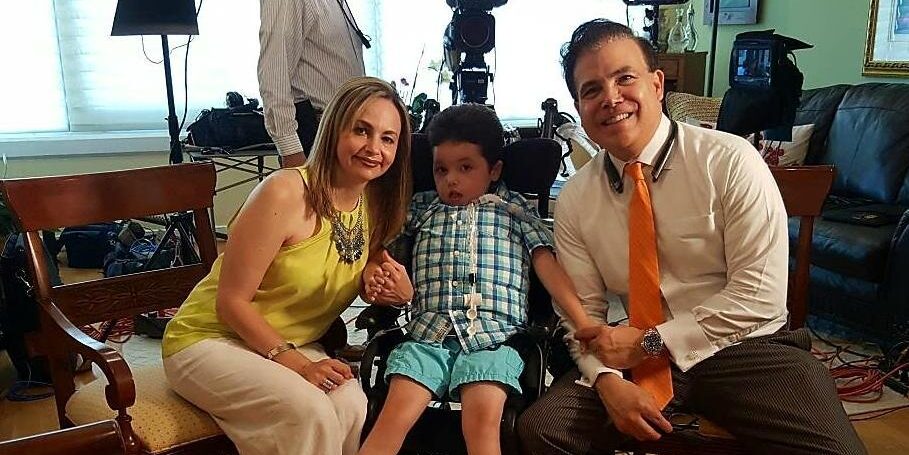
Exoskeletons Improve Movement for Those with Neuromuscular Diseases
By Stephanie Stephens | Thursday, November 6, 2025
Exoskeletons are wearable devices that can provide physical support and improve functional mobility for people with mobility issues, including some with neuromuscular diseases. As their name implies, they have the structure of an “outside skeleton,” but they generally use a power source to assist the user’s movement.
Exoskeletons are most often used to support and assist the lower body due to paralysis or weakness in the spine, hips, and/or legs.
According to Ekso Bionics, an exoskeleton technology company, exoskeletons may improve muscle strength, spasticity, and gait, allowing people with paralysis or other mobility issues to perform daily activities more easily and independently.
Currently, exoskeletons are mainly used in physical therapy (PT) settings, under the guidance of physical therapists (PTs) trained in their use. However, as the technology improves, more devices are becoming available for home use.
Exoskeletons increasingly used in PT
As a recent report in the Expert Review of Medical Devices notes, “Wearable technologies will continue to transform neurorehabilitation by enabling more precise, consistent, and personalized therapy both in the clinic and at home.”
According to Joshua Breighner, PT, DPT, a board-certified clinical specialist in neurologic physical therapy in New York City, that transformation is happening now. Joshua is the owner and Physical Therapy Director of Walk in New York, a partnership with Wandercraft, a manufacturer of self-balancing exoskeletons that enable people with neurological conditions to stand and walk.
Joshua says Wandercraft’s exoskeletons can assist adults with cerebral palsy, multiple sclerosis, and neuromuscular diseases.
PTs conduct thorough screenings to ensure individuals can use exoskeleton devices safely, focusing on range of motion. Whether a person needs to be ambulatory or weight-bearing depends on both the patient and the device.

Doug McCullough uses the Atalante X exoskeleton with physical therapist Joshua Breighner.
Wandercraft’s first version, Atalante X, was introduced in 2019. It is FDA-approved and is available in hospitals and rehabilitation facilities, including some PT clinics. Atalante X fits over the trunk and lower body and is attached to a safety tether. It allows patients with severe gait impairment, including those with upper extremity dysfunction, to stand upright and walk hands-free, mimicking a natural gait. Twelve motors and many sensors throughout the legs and feet enable the device’s self-balancing. The PT can adjust the assistance level to match the patient’s needs.
The company has also developed Eve, the first self-balancing exoskeleton designed for home use, which is currently being evaluated in clinical trials.
Doug McCullough lives in central New Jersey but travels to Manhattan to work with Joshua, using the Atalante X. Diagnosed with spinal muscular atrophy at age 11, Doug learned about Wandercraft at a Global Accessibility Awareness Day event in 2025.
“I first tried an exoskeleton in 2013,” says Doug, 58. “Earlier versions of exoskeletons required users to use crutches or walkers, which is difficult for people with below-average upper-body strength. The Atalante device has the benefit of not needing the user to provide any upper body support.”
Doug began using a power wheelchair periodically two years ago, when it became more difficult to walk long distances or on uneven terrain. Then he broke his thigh bone in a fall.
“I’m still rehabbing my leg, and this device helps me use muscles I haven’t been able to use,” he says. “This technology is very exciting.”
Robotic exoskeletons detect intended movements

Dwayne Wilson used the Hybrid Assistive Limb (HAL) robotic exoskeleton for physical therapy.
For Dwayne Wilson, who was diagnosed with Pompe disease in 2018 at age 50, the Hybrid Assistive Limb (HAL) device is changing the way he moves his muscles during PT. This exoskeleton device resembles a large double leg brace extending from the lower back to the feet.
HAL, manufactured by Cyberdyne, is one of several FDA-approved robotic exoskeletons, a type of exoskeleton that uses sensors to detect bioelectrical signals — the wearer’s intentions — and then perform the appropriate movement, such as taking a step forward.
Practicing walking with HAL at his PT clinic has helped Dwayne improve his balance and rebuild some of his strength and confidence.
“HAL made me feel like I was a superhero in ‘The Avengers’ movies,” says Dwayne, 57, of Irvine, California. “It gave me a greater range of motion, and I could actually do squats with HAL.”
Exoskeletons as assistive aids
In Monument, Colorado, Mary Jane Niles, 70, uses the Hypershell X Go exoskeleton as an assistive aid for walking and everyday motion. She was diagnosed with facioscapulohumeral muscular dystrophy (FSHD) in 1990. In addition to affecting the muscles of the face and upper arms, FSHD can cause weakness in the abdominal, hip, and lower leg muscles.
The Hypershell X Go has a padded waist belt with hinged carbon fiber rods extending down the outsides of the thighs to straps above the knees. Motors at the hips facilitate leg movement.

Mary Jane Niles uses the Hypershell X Go exoskeleton as one of her mobility aids for walking.
Mary Jane says the exoskeleton helps her maintain good posture while using her walker. She also uses ankle-foot orthoses (AFOs) to manage foot drop. Adding the exoskeleton to her mobility aids has helped her extend her mobility without a wheelchair.
She hopes to upgrade to a higher powered Hypershell X model for more assistance on inclines; however, neither Medicare nor private insurance covers this device because it is not manufactured for rehabilitation — and that’s a critical difference.
Anyone who would like to use an exoskeleton device for medical reasons should consult their doctor and request a referral to a physical or occupational therapist for advice on which type is best and whether insurance coverage is available.
Joshua explains that Medicare opened a reimbursement pathway for personal exoskeletons — meaning not solely for use in a clinic — in April 2024. While this is still evolving and every case is reviewed individually, it is a step forward.
“It was a clear acknowledgement that this technology could provide real medical and social benefits,” Joshua says. Medicare classifies exoskeletons as braces and generally covers 80% of the total cost. (Some devices exceed $100,000.) However, as this is still a new area of medical coverage, insurance decisions are made on a case-by-case basis.
Joshua hopes that the availability of exoskeletons and understanding will broaden as they are used more. “To hear what patients say about them is compelling and powerful,” he says.
Next Steps and Useful Resources
- Mobile standers and standing wheelchairs also provide the health benefits of standing. Read more in Stand Up and Go with Mobile Standers and Standing Wheelchairs.
- Learn how MDA’s Durable Medical Equipment (DME) Grant Program can help people with neuromuscular diseases access essential equipment that supports their independence, safety, and mobility.
- Stay up to date on Quest content! Subscribe to Quest Magazine and Newsletter.
TAGS: Equipment and Assistive Devices, Featured Content, Innovation, Technology
TYPE: Blog Post
Disclaimer: No content on this site should ever be used as a substitute for direct medical advice from your doctor or other qualified clinician.




